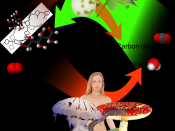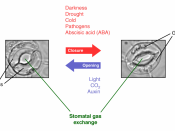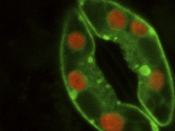Scattered throughout the leaf epidermis are pairs of bean-shaped cells, called guard cells . These cells contain chloroplasts, which are tiny granules filled with chlorophyll . Chlorophyll gives the leaf its green color. Chloroplasts enable leaves to carry on photosynthesis because they are able to absorb sunlight and carbon dioxide, which are essential for the food making process . In response to heat and light, each pair of guard cells pulls apart, and a tiny pore forms between them which are called stoma . Theses tiny pores open to the outside atmosphere in order for carbon dioxide and oxygen to pass either in or out . When carbon dioxide passes in, it takes part in photosynthesis, the food making process in which oxygen is released as a waste . This oxygen passes out of the leaf. At the same time, oxygen also enters the leaf, In order for the plant to carry on cellular respiration, a process in which carbon dioxide is released as a waste .
This carbon dioxide passes out through the stomata. Also, Stoma is essential for the loss of water in the form of a vapor . This process is called transpiration . Generally, there are more stomata on the lower epidermis of a leaf than on the upper epidermis . This prevents water from evaporating too much from the upper side of the leaf, which is exposed to the sun . Stomata close at night, in order to provide another level of water conservation .
The guard cells have thickened and elastic inner walls that lets them to be adapted to open and close . The opening of stomata is caused by an increase in the concentration of water outside of the guard cells . When the concentration of water outside of the guard...


